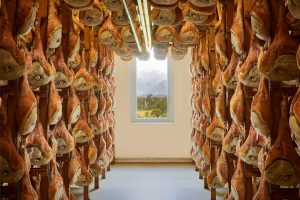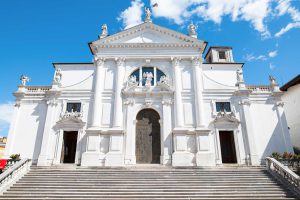San Daniele del Friuli is a destination known around the world for making Prosciutto di San Daniele, but it is also a hub of art and culture: the Guarneriana Library, the oldest in the region, boasts treasures such as a Divine Comedy from the 14th century and rare print editions. In the Church of Sant’Antonio Abate, visitors can admire a stunning cycle of Renaissance frescoes by Martino da Udine, known as ‘Pellegrino da San Daniele’. And that’s not all: the Museo del Territorio houses archeological findings, works of art and artefacts that tell the rich history and culture of this fascinating Friulian city.
The Church of Sant’Antonio Abate
The Church of Sant’Antonio Abate is nicknamed the ‘Sistine Chapel of Friuli’ thanks to the extraordinary frescoes which decorate its walls.
The single-nave building preserves a priceless artistic heritage, a result of the genius of all the master painters that there have been over the centuries. It is mainly known for the three fresco cycles that adorn its walls, the most notable of which is the artwork of Vitale da Bologna, created in the fourteenth century, and that of Martino da Udine, known also as Pellegrino da San Daniele, who worked from 1497 to 1522.
Prophets and Evangelists are painted in the choir vault, whilst on the back wall there rises a magnificent Crucifixion. In the intradoses and along the walls of the choir, the Stories of Sant’Antonio Abate and Christ unfold, with traces of an older cycle still visible which depicts scenes from the Infancy of Christ.
The history of the Church of Sant’Antonio Abate has its roots in the Middle Ages, when it was the Church of the Sant’Antonio Hospital, consecrated back in 1308. It suffered serious damage in 1348, but thanks to reconstruction work it was newly consecrated in 1470.
The Guarneriana Library
The Guarneriana Library was founded in 1466 by order of Guarnerio d’Artegna, a luminary of the time.
Guarnerio d’Artegna trained in Rome, immersing himself in the life of the Roman Curia and embarking on an ecclesiastical career. He returned to Friuli-Venezia Giulia and dedicated part of his life to copying manuscripts, thus preserving priceless works for future generations.
His vision came to fruition when, as a parish priest, he founded a scriptorium in his home of San Daniele del Friuli, which became a renowned centre for copying and preserving texts. On 10 October 1466, a few days before his death, Guarnerio dictated his will, binding his precious library with the Church of San Michele and establishing strict rules for its preservation and use.
And thus the library was born, with an initial collection of 172 manuscripts in Latin, one of the first examples of a public library in Italy. Its public nature and accessibility to the local community attracted many intellectuals, who contributed by donating their own collections, further enriching Guarneriana’s heritage over the centuries.
Amongst the highly valuable works housed in the Guarneriana, the Byzantine Bible stands out, a mysterious codex whose origin and illuminations depict an intriguing mix of Western and Levantine elements. Other manuscripts include humanist works and works by classic Greek and Latin authors which testify to the richness and diversity of the cultural heritage collected over the centuries.
The Cathedral of San Michele Arcangelo
In the centre of San Daniele del Friuli, the Cathedral di San Michele Arcangelo dominates the main piazza.
The Cathedral’s origin can be traced back to the eighteenth century: its construction is an enchanting example of Baroque architecture, which harmoniously blends with the Renaissance atmosphere. Next to the Cathedral stands the old City Hall, now the Guarneriana Library, adding further charm and history to this sacred place.
The Cathedral has been through critical times: during the autumn of 1944, the façade suffered irreparable damage from allied bombing. In the spring of 1945, the Cathedral was threatened again by gunfire from retreating Nazi tanks, which narrowly missed the sacred building.
The earthquake of 1976 also left its mark on the Cathedral, causing further damage to the structure.
Inside the Cathedral, three naves welcome visitors, adorned with works of art and sacred treasures. Amongst these, the Baptismal font from the 16th century and the precious canvas of the Holy Trinity of Pordenone. Another Cathedral gem is its magnificent organ, one of the largest in the region, with three keyboards and over three thousand reeds.
The Museo del Territorio
A tour of San Daniele del Friuli is not complete without a visit to the Museo del Territorio. Located in the charming seventeenth-century cloister of the old hospital, formerly a Dominican convent, this museum embodies a valuable cultural space of historic and artistic heritage which spans centuries of life and culture in the Friulian region.
The San Daniele Museo del Territorio stands out thanks to its collection, that ranges from archaeological finds to religious works of art and ethnographic objects. Divided into three major sections (archaeology, religious art and ethnography), the museum offers visitors a fascinating journey through the ages and local traditions.
The museum’s archaeological section features a wide range of artefacts from digs and archaeological finds carried out in the region. Thanks to the artefacts exhibited it’s possible to trace the evolution of life in the region and discover more about the area’s past 1,000 years.
In the section dedicated to religious art, visitors can admire priceless works from local churches, including two wooden alters from the churches of S. Antonio Abate and S. Maria della Fratta. The section also includes a rich collection of paintings on panels and on canvas, as well as remains of frescoes dating back to the 14th and 15th centuries, which offer a glimpse into the fertile artistic production which has characterised the region over the centuries.
The Portonat
Porta Gemona, or Portonat, stands as a monumental entrance to the historic centre of San Daniele del Friuli. Built in 1579 from the designs of Andrea Palladio, the gate seamlessly fits into the pre-existing medieval city walls, becoming a distinctive element rich with history.
Palladio’s work is characterised by its elegance and composure. The semicircular arch, framed by rusticated ashlars, dominates the structure, whereas the broken triangular pediment, decorated with emblems and inscriptions, brings out its solemn character. On the sides, two niches house allegorical statues, whilst a panoramic balcony offers a picturesque view of the city.
The Portonat is not only a simple gate, but a true architectural jewel which evidences the genius of Palladio and his skill in combining functionality and aesthetics. Passing through this gate means immersing yourself in the history of San Daniele and letting the beauty of its architecture enchant you.
In addition to its historical and artistic value, the Portonat represents an important symbol for the San Daniele community. The gate embodies the city’s strength and resilience, which over the centuries has been able to withstand wars, earthquakes and plagues. Today, the Portonat is a landmark loved by citizens and tourists alike, a place which invites you to discover the wonders and treasures that San Daniele holds within.






